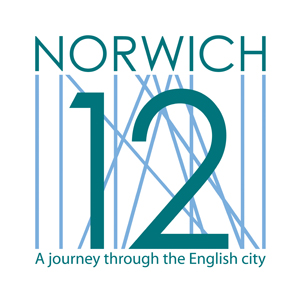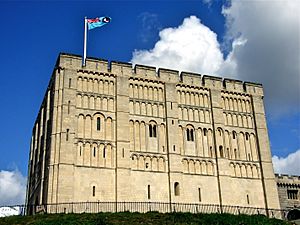Norwich 12 facts for kids
Norwich 12 was a special project in the city of Norwich, England. It was created by a group called Norwich Heritage Economic and Regeneration Trust (HEART). The idea was to highlight 12 of Norwich's most famous buildings. These buildings were chosen to show how English cities and culture have grown over the last 1,000 years.
Norwich HEART received £1 million to start this exciting project. The 12 buildings show different types of architecture. They include styles from the Norman period, the medieval times, the Georgian and Victorian eras, and even modern times. The "Norwich 12" idea officially began in the summer of 2008.
Contents
- The Norwich 12 Buildings: A Journey Through Time
- Norwich Castle: A King's Fortress (1067–1075)
- Norwich Cathedral: A Giant Norman Church (1096–1145)
- The Great Hospital: Helping People for Centuries (1249)
- The Halls: A Medieval Friary (1307–1470)
- The Guildhall: Norwich's Old City Hall (1407–1424)
- Dragon Hall: A Merchant's Home (1427–1430)
- The Assembly House: Fun for the Gentry (1754–1755)
- St James Mill: An Industrial Powerhouse (1836–1839)
- Cathedral of St John the Baptist: A Grand 19th-Century Church (1884–1910)
- Surrey House: A Stunning Edwardian Office (1900–1912)
- City Hall: Modern Government Building (1936–1938)
- The Forum: A 21st-Century Hub (1999–2001)
- Exploring the Norwich 12
- SHAPING 24: Connecting Norwich and Ghent
The Norwich 12 Buildings: A Journey Through Time
Norwich Castle: A King's Fortress (1067–1075)
Norwich Castle is a very old Norman building. It was first built as a royal palace for William the Conqueror. Back then, most buildings were small and made of wood. This huge stone castle showed everyone how powerful the king was.
The castle sits on the biggest man-made hill (called a motte) in England. From the 1300s to the 1800s, the castle was used as a county jail. In 1894, it was turned into a museum, which you can visit today.
Norwich Cathedral: A Giant Norman Church (1096–1145)
Most of Norwich Cathedral was built by the Normans. It is one of the best examples of Romanesque style in Europe. Like the Castle, its huge size showed the power of the Norman invaders.
Special stone from Caen in Normandy was brought over. Building the Cathedral needed many workers, like masons and glaziers. Some of the original Norman wall paintings can still be seen inside.
Norwich Cathedral has the tallest Norman tower in England (40 metres). It also has the largest monastic cloisters (covered walkways) and unique medieval roof carvings. A new visitor centre opened in 2009.
The Great Hospital: Helping People for Centuries (1249)
Norwich's Great Hospital has been helping people for over 750 years. It was started in the 1200s to care for poor priests. This large group of buildings and its old records show a living history of the past seven and a half centuries.
The site includes the old church of St Helen. It also has the Eagle Ward, which has a beautifully decorated 'eagle ceiling.' There's a dining hall, cloisters, and buildings from the 1400s and 1500s. Later additions include 1800s almshouses (homes for the poor) and St Helen's House from the 1700s.
Today, the hospital still provides sheltered housing and a care home for older people.
The Halls: A Medieval Friary (1307–1470)
The Halls are a group of amazing flint buildings. They make up the most complete friary (monk's complex) still standing in England. St Andrew's Hall was once the main part of a new church, finished in 1449. The first friary here was destroyed by fire.
During the Reformation, the city council saved the site. They bought it from the king to use as a 'common hall.' Since then, it has been used for worship, as a place to make coins, and as a workhouse.
Today, the two main halls, a crypt (underground room), a chapel, and cloisters host many events. These include conferences, fairs, weddings, and concerts.
The Guildhall: Norwich's Old City Hall (1407–1424)
The grand design and size of Norwich Guildhall show how rich and important Norwich was in medieval times. It was one of the wealthiest cities in England outside of London.
This building shows the growing power of the city's new leaders. These were rich merchants and traders. Norwich gained more self-governing powers in 1404. The Guildhall was built to hold the city's meetings, councils, and courts. These groups made rules for the citizens.
You can still see signs of these old functions, which continued until the 1900s. Other parts of the building are now used by businesses.
Dragon Hall: A Merchant's Home (1427–1430)
Dragon Hall was a medieval trading hall. It was built by Robert Toppes, a very rich local merchant, for his business. The top floor of this 27-metre timber-framed hall has a special roof. It has a carved dragon, which gives the building its name.
After Toppes died, the building was changed into homes. In the 1800s, it was divided into shops, a pub, and small apartments. The amazing dragon roof was hidden for many years. It was only found again in the 1980s.
Dragon Hall then became a place for visitors. It also hosts weddings, parties, and performances.
The Assembly House: Fun for the Gentry (1754–1755)
The Assembly House is a Georgian building. It was designed by the architect Thomas Ivory. It uses the same layout as an older building, a medieval college.
When it opened, the Assembly House was a place for entertainment for the local rich people (gentry). Over its long history, it has hosted a waxworks exhibition by Madame Tussaud. The famous composer Franz Liszt also gave a concert here. Many fancy balls were held too.
Today, the rooms look almost exactly as they did during the Regency period. They are used for art shows, concerts, meetings, and weddings.
St James Mill: An Industrial Powerhouse (1836–1839)
St James Mill is a classic example of an English Industrial Revolution mill. It was built in a part of the UK where you might not expect to find one. The site was once used by monks (Carmelites) in the 1200s. An original arch and underground room (undercroft) from that time still exist.
When the local textile business slowed down, Jarrold & Sons Ltd bought St James Mill in 1902. They used it for their printing department. Later, it was rented to a chocolate maker and then sold to the government. The government used it as a training factory for war veterans in 1920.
Jarrolds bought the mill back in 1933. Today, it is a private office building. The John Jarrold Printing Museum is located behind the mill and is open most Wednesdays.
Cathedral of St John the Baptist: A Grand 19th-Century Church (1884–1910)
The Cathedral of St John the Baptist is an example of 19th-century Gothic revival architecture. By the 1800s, Catholics were allowed to worship in public again. The Cathedral was a gift to the city from Henry Fitzalan Howard, the 15th Duke of Norfolk. He wanted to bring Catholicism back into the heart of English life.
It was designed by George Gilbert Scott Junior. It has beautiful stained glass from the 1800s and many stone carvings. The Cathedral also includes the Narthex, which is a new visitor centre.
Surrey House: A Stunning Edwardian Office (1900–1912)
Surrey House is one of the most beautiful and grand Edwardian office buildings in Britain. It is the historic home of Aviva, a large insurance company. The building was designed by George Skipper. The company wanted a "splendid yet functional office space." It includes Greek influences and themes of insurance and protection. This was to show customers how strong and successful the company was.
The building has an impressive outside design. Inside, it is decorated with 15 types of marble, classical paintings, and a stunning glass roof. It also has unusual items, like an 'air fountain' and a special chiming clock from the Great Exhibition of 1851.
City Hall: Modern Government Building (1936–1938)
Norwich City Hall was finished in 1938. The old Guildhall and other offices were too small for the growing local government.
The city council asked the Royal Institute of British Architects (RIBA) for help. They held a competition to design a new building for the city.
City Hall has an art deco style inside. It features a dome on the top floor, rich mahogany wood panels, and one of the longest balconies in England.
The Forum: A 21st-Century Hub (1999–2001)
The Forum is a landmark building for East Anglia. It shows excellent 21st-century design. It was funded by the Millennium Commission and local councils.
This modern building houses the Norfolk & Norwich Millennium Library. It also has the 2nd Air Division Memorial Library, the Norwich Tourist Information Centre, a café, and a restaurant. It is also home to BBC East's main offices.
In 2009, it opened new community facilities. These include Fusion, Europe's largest permanent digital art gallery, and a modern auditorium. The Forum hosts many free and ticketed events, exhibitions, and entertainment all year round.
Exploring the Norwich 12
While not all of the Norwich 12 buildings are open to the public every day, a main goal of the project was to make them easier to visit.
You can explore all 12 buildings in different ways. There are guided walks and tours, special exhibitions, and music performances. You can also learn about them through leaflets, signs, websites, and guide books.
Special Information Totems
Special information signs, called totems, were placed next to each of the 12 buildings. These signs tell you important names and dates about the buildings. They also had bluetooth technology. This allowed them to send extra information to mobile phones.
SHAPING 24: Connecting Norwich and Ghent
SHAPING 24 was an award-winning project. It was also managed by Norwich HEART, working with the city of Ghent in Belgium. This project connected the Norwich 12 buildings with 12 heritage sites in Ghent.
The project aimed to show the long history of connections between the East of England and the Low Countries (like Belgium).
SHAPING 24 won a special award in 2014. It received the European Union Prize for Cultural Heritage / Europa Nostra Awards for Education, Training and Awareness-Raising. The project received some of its funding from the European Union.
Ghent's 12 Heritage Sites
The 12 heritage sites in Ghent, Belgium, are:
- St Bavo's Abbey
- St Peter's Abbey
- St Bavo's Cathedral
- Castle of the Counts
- St Nicolas' Church
- Beguinages
- Lange Violettestraat
- Sint-Amandsberg
- Bijloke Monastery Site
- The Belfry
- Ghent City Hall
- Hotels
- Hotel Clemmen
- Hotel d'Hane-Steenhuyse
- Museum of Fine Arts
- Book Tower





